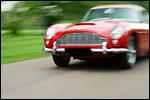
This is a bit far afield, perhaps, but the British press is reporting that new drivers in the UK will soon have to take an “eco-driving” test in order to get their license. The UK initiative is modelled after a Dutch program that claims that smarter driving habits — slower acceleration, less braking, lower top speeds — can shave gas consumption by a third or more.
Last year, after a brief (and undeserved) flap over they Toyota Prius’s worse-than-advertised mileage, ardent hybrid enthusiasts began circulating advice about how to maximize the vehicles’ efficiency. So it’s good to see some effort to do the same thing for the 99+ percent of cars on the road that aren’t hybrids.
But more interesting to me was this snippet from the UK article: “modern family vehicles are as powerful as the 1960s Monte Carlo rally cars.”
Could this be really be true? Well, in fact, it’s a bit of an understatement.
Take, for example, the Porsche 911, the car that won the 1970 Monte Carlo rally. According to Wikipedia, the engine of the entry-level 911 was rated at 125 horsepower, the high-end model at 180 horsepower.
Fast forward to today. The bottom-of-the-line Ford Focus — hardly a speedster by today’s standards — has an engine rated at 136 horsepower. The “family sized” Crown Victoria‘s engine is rated at 224 hp.
I’m no car buff, but I’m pretty sure there’s more to a car’s performance than its raw horsepower rating. Still, it’s fascinating to see that engine technologies have gotten not just slightly better, but massively better over the past 3 decades or so — but that most of those improvements have been sunk into performance (faster acceleration, higher top speeds, and the like) and size. Very little has gone toward improved fuel efficiency.
Of course, it doesn’t feel as though today’s Ford Focus performs like yesteryear’s Porsche 911. But that’s mostly an artifact of rising expectations. We’ve reached the point where sports-car performance seems like a necessity on a crowded, high-speed superhighway. And with so many massive and powerful cars filling the roads, it’s little wonder that people question the viability of small-but-efficient vehicles — even if they would have qualified as race cars a few decades ago.


